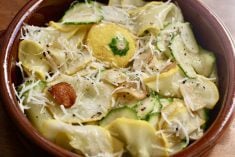May traditionally brings into effect the 3 Gs Ñ garage sales, good food and great weather. Let’s start with garage sales.
Kathy Peel, author of The Family Manager’s
Everyday Survival Guide, shares some great tips on turning trash into cash:
- Take inventory to
determine if there is enough stuff to put on a good sale. If not, invite friends, family or neighbours to join you. - Set an appropriate date. Avoid holiday weekends since many garage sale regulars may be away.
- A week or two before the sale, place an ad in the local paper. Make ads short, include dates, times, sampling of merchandise, address and brief directions if you are out of the way. Do not include your phone number unless you are selling specific items that people may have questions about.
- Make notices to put up on community event boards, at the local coffee shop, grocery store and on corner posts. Make signs legible and eye-catching. Advise neighbours about your sale.
- Price the merchandise with stickers or masking tape. Do not mark prices directly on articles because some ink may not come out.
- Make prices easy by sticking to amounts that require the least amount of change. It is easy to price in increments of 25 cents.
- Do not misrepresent the merchandise. If an item is damaged, be sure to mark it with a sign “as is”
on it. - Prices should be at least 20 to 30 percent of current retail value depending on condition of the item.
- Have at least $20 in quarters, dimes and nickels, a few fives, tens and twenties, and $50 in loonies and toonies.
- Be sure that you have extension cords available to check items that require power.
- Set up as much as possible the day before the sale. If the sale is in your driveway or yard, set out tables and racks if weather permits and have merchandise arranged for easy setup in the morning.
- Take down signs after the sale.
Read Also

Alberta cracks down on trucking industry
Alberta transportation industry receives numerous sanctions and suspensions after crackdown investigation resulting from numerous bridge strikes and concerned calls and letters from concerned citizens
The weather agenda
There is nothing like getting outside to feel the warmth of the sun. Fortunately, we can enjoy the sun without worry by using sunscreen. All sunscreens have a sun protection factor on their labels.
The SPF represents the length of time that sunscreen-protected skin can be exposed to ultraviolet rays before a minimal redness appears, compared to the length of time it takes on unprotected skin.
For example, if you apply a sunscreen of SPF 15, you could spend up to 300 minutes under the sun before sunburning. That is 15 times longer than if you were not protected. However, this does not mean that damage to your skin, other than sunburning, has not already started.
For best results, apply the sunscreen at least 20 minutes before going out in the sun.
Reapply it 20 minutes after you go out, so that the product stabilizes on your skin and gives you maximum protection.
It is also important to protect your eyes. For most people, an inexpensive pair of sunglasses will do.
Choose sunglasses with lenses that are dark enough to keep your eyes comfortable, but not so dark that they reduce your vision.
Regular lenses reduce the brightness of everything evenly. Polarizing lenses are designed to cut glare due to reflection, which means they are good for driving and outdoor activities in the snow or on water. Photochromic lenses change with the intensity of UV light by turning darker when outdoors and lighter when indoors.
If you wear these for driving, choose sunglasses that are fairly dark. Mirror lenses reflect all or part of the light instead of absorbing it. They offer no performance advantage because they scratch easily.
You cannot tell how much UV protection a pair of sunglasses provide by the price or darkness of the lenses. Look for a label that lists the type, and amount of protection.
On to good food.
Grilled steak salad
1 cup balsamic 250 mL
vinaigrette dressing, divided
2 beef sirloin steaks
(3Ú4 lb./375 g), 1Ú2 to 3Ú4 inch
(1-2 cm) thick
2 large yellow peppers, cut
in half lengthwise, seeded
8 cups salad greens 2 L
or spring greens
3 large tomatoes, cut
into wedges
1Ú2 cup thinly sliced red 125 mL
onion
Preheat greased barbecue to medium-high heat. Remove 2Ú3 cup (150 mL) of the dressing; cover and refrigerate for later use.
Brush remaining dressing lightly onto one side of the steak and inside the pepper halves.
Grill steak and peppers 10 minutes or until steak is cooked through, turning steak over after five minutes.
Meanwhile, arrange greens, tomatoes and onions evenly on four individual serving plates. Cut steak across the grain into thin slices; cut yellow peppers into strips. Arrange steak and peppers over greens. Drizzle evenly with the reserved dressing.
Unbleached flour
Dear TEAM: I would like information about bleached and unbleached flour. What chemical and process is used in milling bleached flour? Does the regular all-purpose flour have the same nutritional value as unbleached? Ñ I.C., Beechy, Sask.
Dear I.C.: I contacted Robin Hood and here is the response:
“We use benzoyl peroxide to bleach our Robin Hood all-purpose flour. The same milling process is used for both unbleached and bleached flour.
“As for how much bleaching agent we add to the bleached flour, unfortunately we cannot share this information with you because it is proprietary information. The nutritional value of the different flours is exactly the same.”
For recipes, contests and more
information, visit www.robinhood.ca or phone 800-268-3232.
Here are two recipes from Robin Hood.
Apple blondies
2Ú3 cup butter, softened 150 mL
2 cups brown sugar, 500 mL
packed
2 eggs
1 teaspoon vanilla 5 mL
2 cups all-purpose 500 mL
flour
2 teaspoons baking 10 mL
powder
1Ú4 teaspoon salt 1 mL
1 cup apples, peeled, 250 mL
cored, chopped
1Ú2 cup walnuts or 125 mL
pecans, chopped
Icing
1Ú2 cup butter 125 mL
1 cup brown sugar, 250 mL
packed
1Ú4 cup milk 60 mL
2 cups icing sugar, 500 mL
sifted
Cream butter and brown sugar in a bowl until smooth. Add the eggs and vanilla and mix well.
Stir in the flour, baking powder, salt, apples and nuts. Stir until thoroughly combined.
Spread batter in a greased 13 x nine inch (33 x 22 cm) baking pan. Bake at 350 F (180 C) for 30-35 minutes, or until set and golden. Let cool slightly before icing.
To make icing: melt butter in a saucepan, add the brown sugar and milk and bring the mixture to a boil. Remove from heat; let cool and stir in icing sugar. Spread onto cooled blondies. Cut into squares and serve.
Chocolate raspberry squares
Young baker, Alina Jones, won the 2004 lunch box snack contest at the Pipestone-Albert Agricultural Fair in Sinclair, Man., with this recipe.
13Ú4 cups all-purpose 425 mL
flour
1 cup granulated 250 mL
sugar
1 cup butter 250 mL
1 egg , beaten
1Ú2 teaspoon almond 2 mL
extract
1 cup raspberry jam 250 mL
1Ú2 cup chocolate 125 mL
chips
In a bowl, combine the flour and sugar. Cut in the butter with a pastry blender until crumbly.
Add the egg and almond extract. Mix well. Set aside one cup (250 mL) of the mixture for the top. Press remaining dough in a greased eight inch (20 cm) square cake pan. Spread the jam on top and sprinkle reserved crumbles over jam.
Bake at 350 F (180 C) for 35-40 minutes or until light golden. Quickly sprinkle chocolate chips on top of warm squares. Cool completely, cut into squares and serve.
Jodie Mirosovsky is a home economist from Rosetown, Sask., and one of four columnists comprising Team Resources. Send correspondence in care of this newspaper, Box 2500, Saskatoon, Sask., S7K 2C4 or contact them at team@
producer.com.














